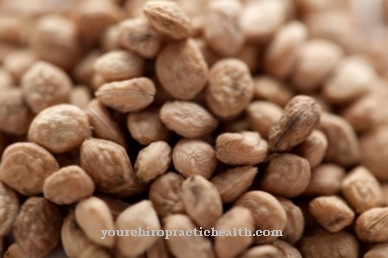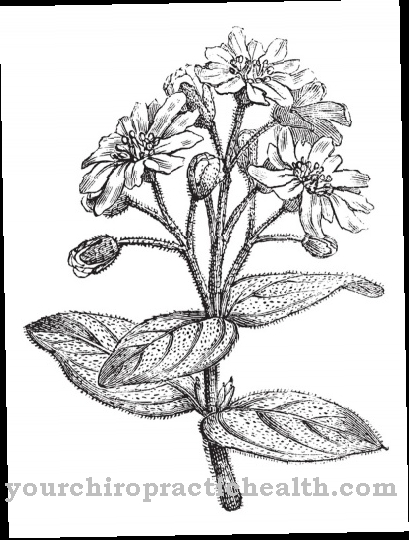The Aztec sweet herb is an ornamental plant which, because of its sweetness, is also an alternative to the stevia plant. In addition, the Aztec sweet herb is a very old medicinal plant that was used as a universal medicine by the Aztec people.
Occurrence and cultivation of the Aztec sweet herb

The dark green leaves of the Aztec sweet herb are oval in shape and about 3 to 4 centimeters long. The typical small white flowers of the plant appear on the leaf axils between June and September. Because of their tendril formation, the Aztec sweet herb is often used to plant hanging baskets. The scent of the Aztec sweet herb is described as very aromatic with minty and honeydew melon components.
Aztec sweet herbs thrive best on a soil made of clay and sand, the plant loves a sunny location, but grows correspondingly more slowly in the shade. The Aztec sweet herb is just as suitable as a houseplant as it is as a cultivation plant in the winter garden. As a cultivated plant, Aztec sweet herb is considered to be rather undemanding and easy to care for.
Effect & application
The cuttings from the woody tendril parts of the plant can be easily grown on permeable soils. However, Aztec sweet herb does not tolerate frost, which should also be taken into account when growing in pots or hanging baskets. If the plant is not moved to a bright and cool place above freezing in winter, it will perish.
However, the plant does not mind if the meter-long tendrils are cut back from time to time in order to avoid uncontrolled growth. Aztec sweet cabbage is harvested all year round, the leaves can either be used fresh after harvest or also gently dried and stored in a cool and dry place for a longer period of time.
It is said that Aztec sweet herb was used by the Aztecs as a universal remedy and was therefore used successfully against a variety of diseases and ailments. The traditional Aztec name Tzopelic Xihuitl is no longer in common use today. The Spanish doctor Hernández mentioned the Aztec sweet herb in a scientific article in the 16th century and praised its great healing powers.
The use as a medicinal plant is nowadays more and more in the background. Aztec sweet herb is known to its users today rather as an ornamental plant or as a natural sweetener. Similar to the stevia plant, Aztec sweet herb also has a sweetness that exceeds that of table sugar by around 1000 times.
The finely chopped leaves can either be used directly for the preparation of desserts or pressed beforehand for this purpose. A tea infusion can also be prepared from the whole leaves, which then no longer has to be sweetened. A steeping time of at least 10 minutes is recommended so that all the valuable ingredients pass into the tea brew.
However, avoid boiling the leaves, as otherwise some ingredients would be destroyed, but the sweetening power would remain unaffected by a boiling process. An alcoholic tincture can also be made from the leaves, which has beneficial effects on gastrointestinal problems.
The fresh root of the Aztec sweet herb is also known under the name Tzopelica Cococ and can be chewed directly. The root can also be gargled as a cold extract with lukewarm water. Both types of preparation help against annoying dry coughs due to their soothing effect on the mucous membranes.
Importance for health, treatment & prevention
The importance of the Aztec sweet herb for health and treatment among the Aztec people is well known. Today verbena is used as an ornamental plant and as a natural sweetener. Although the plant is not poisonous, Aztec sweet herbs should not be used in large quantities or over a long period of time.
The main areas of application as a medicinal herb are disorders in the gastrointestinal tract and for coughs of various causes. The healing effect is soothing, relaxing and expectorant. The Aztec sweet herb is also said to have stimulating and toning properties. In gynecology, a menstruation-promoting effect could be determined.
In the case of asthma, shortness of breath, bronchitis, cold, cough, colic, indigestion and constipation, a therapeutic attempt as naturopathic support for conventional medical treatment is worthwhile. Contraindications or side effects are not to be expected when used as intended.
Accidental overdose, however, can lead to serious, albeit reversible, side effects. In addition to temporary amnesia, epileptic seizures as well as twilight and confused states have also been described in this context. However, allergies or hypersensitivity reactions to the ingredients of the Aztec sweet herb are not known.
However, interactions with other medicinal products cannot be ruled out due to the large number of ingredients in the medicinal plant. It is therefore advisable to consult a doctor before each use. The medicinal herb can also be used in children. Aztec sweet herbs contain a variety of essential oils, as well as hernandulcin, camphor, quercetin and sesquiterpene.
These pharmacologically active substances are contained in the whole plant, i.e. flowers, leaves and roots, and as a whole are responsible for the healing effects. Aztec sweet herbs must not be used during pregnancy and breastfeeding, as well as in the case of manifest kidney disease.

















.jpg)



.jpg)

.jpg)




